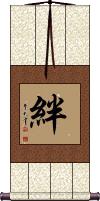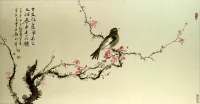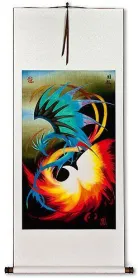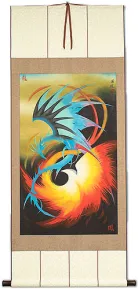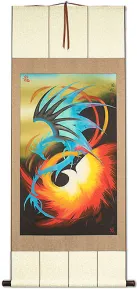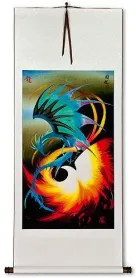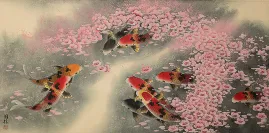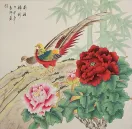Many custom options...
And formats...

Father and Son in Chinese / Japanese...
Buy a Father and Son calligraphy wall scroll here!
Personalize your custom “Father and Son” project by clicking the button next to your favorite “Father and Son” title below...
Father and Son
Father and Son
No one knows a son better than the father
知子莫若父 can be translated as “No one knows a son better than his father.”
This idiom is based on the idea that after spending many years together, family members know everything about each other. Better than anyone else, a father knows the qualities and shortcomings of his son.
If you are looking for something about “father and son,” this is probably the best selection.
While this is the original proverb (very old), others have been composed about various combinations of mothers, sons, daughters, and fathers. Let me know if you need a custom version.
Bond
This Kanji represents a bond, as in the bond between mother and daughter, father and son, family ties, or a family bond.
絆 is the kind of character that says, no matter what happens (difficult times), we have this bond that cannot be broken.
If you go to the Japanese dictionary, the definition is the bonds (between people), (emotional) ties, relationship, connection, link, tether, or fetters.
Read this before ordering...
This Kanji is best if your audience is Japanese. While this is also a Chinese character, it has a completely different meaning in Chinese (it means to hinder or stumble in Chinese).
it’s
a very rare character in Korean Hanja but does mean bond in Korean (used in Korean words for certain kinds of glue and sticking plaster).
This in-stock artwork might be what you are looking for, and ships right away...
Gallery Price: $322.00
Your Price: $178.88
Gallery Price: $60.00
Your Price: $36.88
Gallery Price: $60.00
Your Price: $36.88
Chinese Golden Pheasant and Flower Painting
Discounted Blemished
Gallery Price: $63.00
Your Price: $35.00
Gallery Price: $265.00
Your Price: $99.88
Not the results for Father and Son that you were looking for?
Below are some entries from our dictionary that may match your Father and Son search...
| Characters If shown, 2nd row is Simp. Chinese |
Pronunciation Romanization |
Simple Dictionary Definition |
父慈子孝 see styles |
fù cí zǐ xiào fu4 ci2 zi3 xiao4 fu tz`u tzu hsiao fu tzu tzu hsiao |
More info & calligraphy: Love Between Child and Parents |
三位 see styles |
sān wèi san1 wei4 san wei sanmi; sani さんみ; さんい |
(1) (esp. さんい) third place; third rank; (2) (esp. さんみ) third rank (in the Japanese court system); (3) {Christn} (esp. さんみ) Trinity; the Father, the Son, and the Holy Spirit; (surname) Mitsui three stages |
三従 see styles |
sanjuu / sanju さんじゅう |
a woman's three obediences (father, husband and son; according to Buddhist and Confucianist teachings); (personal name) Mitsugu |
三從 三从 see styles |
sān cóng san1 cong2 san ts`ung san tsung san shō |
A woman's three subordinations, to father, husband, and son; stated in several sūtras, e.g. 四十華嚴經28. |
亞所 亚所 see styles |
yà suǒ ya4 suo3 ya so |
Azor (son of Eliakim and father of Zadok in Matthew 1:13-14) |
撒督 see styles |
sā dū sa1 du1 sa tu |
Zadok (son of Azor and father of Achim in Matthew 1:13) |
撿骨 捡骨 see styles |
jiǎn gǔ jian3 gu3 chien ku |
bone-gathering, a custom of Fujian and Taiwan in which a son recovers the bones of his deceased father from the grave and places them in an urn for permanent storage at a different location |
父子 see styles |
fù zǐ fu4 zi3 fu tzu fushi ふし |
father and son father and child; father and son; father and daughter; (place-name) Chichishi fathers and sons |
翁婿 see styles |
wēng xù weng1 xu4 weng hsü |
father-in-law (wife's father) and son-in-law |
貴賤 贵贱 see styles |
guì jiàn gui4 jian4 kuei chien kizen きせん |
noble and lowly; high versus low social hierarchy of ruler to people, father to son, husband to wife in Confucianism high and low; all ranks Dear and cheap; noble and base; your and my. |
馬但 马但 see styles |
mǎ dàn ma3 dan4 ma tan |
Matthan, son of Eleazar and father of Jakob in Matthew 1.15 |
毘璢璃 毗璢璃 see styles |
pí liú lí pi2 liu2 li2 p`i liu li pi liu li Biruri |
Virūḍhaka. Known as Crystal king, and as 惡生王 Ill-born king. (1) A king of Kośala (son of Prasenajit), destroyer of Kapilavastu. (2) Ikṣvāku, father of the four founders of Kapilavastu. (3) One of the four mahārājas, guardian of the south, king of kumbhāṇḍas, worshipped in China as one of the twenty-four deva āryas; colour blue. Also, 毘璢王; 流離王; 婁勒王 (毘婁勒王); 樓黎王 (維樓黎王); 毘盧釋迦王 (or 毘盧宅迦王); 鼻溜茶迦, etc. |
白飯王 白饭王 see styles |
bái fàn wáng bai2 fan4 wang2 pai fan wang Byakuhan ō |
Śuklodana-rāja, a prince of Kapilavastu, second son of Siṃhahanu, father of Tiṣya 帝沙, devadatta 調達, and Nandika 難提迦. Eitel. |
羅睺羅 罗睺罗 see styles |
luó huó luó luo2 huo2 luo2 lo huo lo Ragora |
Rāhula, the eldest son of Śākyamuni and Yaśodharā; also羅睺; 羅吼; 羅云; 羅雲; 曷怙羅 or 何怙羅 or 羅怙羅. He is supposed to have been in the womb for six years and born when his father attained buddhahood; also said to have been born during an eclipse, and thus acquired his name, though it is defined in other ways; his father did not see him till he was six years old. He became a disciple of the Hīnayāna, but is said to have become a Mahāyānist when his father preached this final perfect doctrine, a statement gainsaid by his being recognized as founder of the Vaibhāṣika school. He is to be reborn as the eldest son of every buddha, hence is sometimes called the son of Ānanda. |
補羯娑 补羯娑 see styles |
bǔ jié suō bu3 jie2 suo1 pu chieh so fukasha |
paulkasa, an aboriginal, or the son 'of a śūdra father and of a kshatryā mother' (M.W.); intp. as low caste, scavenger, also an unbeliever (in the Buddhist doctrine of 因果 or retribution). |
補羯婆 see styles |
bǔ jié pó bu3 jie2 po2 pu chieh p`o pu chieh po |
[Note: 婆 should probably be 娑] paulkasa, an aboriginal, or the son 'of a śūdra father and of a kshatryā mother' (M.W.); intp. as low caste, scavenger, also an unbeliever (in the Buddhist doctrine of 因果 or retribution). |
阿闍世 阿阇世 see styles |
ā shé shì a1 she2 shi4 a she shih ajase あじゃせ |
(surname) Ajase Ajātaśatru, 阿闍貰; 阿闍多設咄路; 未生怨 'Enemy before birth'; a king of Magadha whose father, Bimbisāra, is said to have sought to kill him as ill-omened. When grown up he killed his father and ascended the throne. At first inimical to Śākyamuni, later he was converted and became noted for his liberality; died circa 519 B.C. Also called 'Broken fingers' and Kṣemadarśin. His son and successor was Udāyi; and a daughter was ? Aśu-dharā. According to a Tibetan legend an infant son of Ajātaśatru was kidnapped, or exposed, and finally became king of Tibet named ~Na-khri-btsan-po. |
三從四德 三从四德 see styles |
sān cóng sì dé san1 cong2 si4 de2 san ts`ung ssu te san tsung ssu te |
Confucian moral injunctions for women, namely: obey in turn three men father, husband and son, plus the four virtues of morality 德[de2], physical charm 容, propriety in speech 言 and efficiency in needlework 功 |
三綱五常 三纲五常 see styles |
sān gāng wǔ cháng san1 gang1 wu3 chang2 san kang wu ch`ang san kang wu chang |
three principles and five virtues (idiom); the three rules (ruler guides subject, father guides son and husband guides wife) and five constant virtues of Confucianism (benevolence 仁, righteousness 義|义, propriety 禮|礼, wisdom 智 and fidelity 信) |
五障三從 五障三从 see styles |
wǔ zhàng sān cóng wu3 zhang4 san1 cong2 wu chang san ts`ung wu chang san tsung goshō sanshō |
The five hindrances to woman, see above, and her three subordinations, i. e. to father, husband. and son. |
以利亞敬 以利亚敬 see styles |
yǐ lì yà jìng yi3 li4 ya4 jing4 i li ya ching |
Eliakim (name, Hebrew: God will raise up); Eliakim, servant of the Lord in Isaiah 22:20; Eliakim, son of Abiud and father of Azor in Matthew 1:13 |
月光童子 see styles |
yuè guāng tóng zǐ yue4 guang1 tong2 zi3 yüeh kuang t`ung tzu yüeh kuang tung tzu Gakkō Dōshi |
月光兒 The son of an elder of the capital of Magadha, who listening to heretics and against his son's pleadings, endeavoured to destroy the Buddha in a pitfall of fire, but, on the Buddha's approach, the fire turned to a pool and the father was converted; the son was then predicted by the Buddha to be king of China in a future incarnation, when all China and the Mongolian and other tribes would be converted, v. 月光童子經. |
父子親密 父子亲密 see styles |
fù zǐ qīn mì fu4 zi3 qin1 mi4 fu tzu ch`in mi fu tzu chin mi fûshi shinmitsu |
father and son shall be intimate |
The following table may be helpful for those studying Chinese or Japanese...
| Title | Characters | Romaji (Romanized Japanese) | Various forms of Romanized Chinese | |
| Father and Son | 父息子 | chichi musuko chichimusuko | ||
| Father and Son | 父與子 父与子 | fù yù zǐ fu4 yu4 zi3 fu yu zi fuyuzi | fu yü tzu fuyützu |
|
| No one knows a son better than the father | 知子莫若父 | zhī zǐ mò ruò fù zhi1 zi3 mo4 ruo4 fu4 zhi zi mo ruo fu zhizimoruofu | chih tzu mo jo fu chihtzumojofu |
|
| Bond | 絆 绊 | kizuna | bàn / ban4 / ban | pan |
| In some entries above you will see that characters have different versions above and below a line. In these cases, the characters above the line are Traditional Chinese, while the ones below are Simplified Chinese. | ||||
Successful Chinese Character and Japanese Kanji calligraphy searches within the last few hours...



